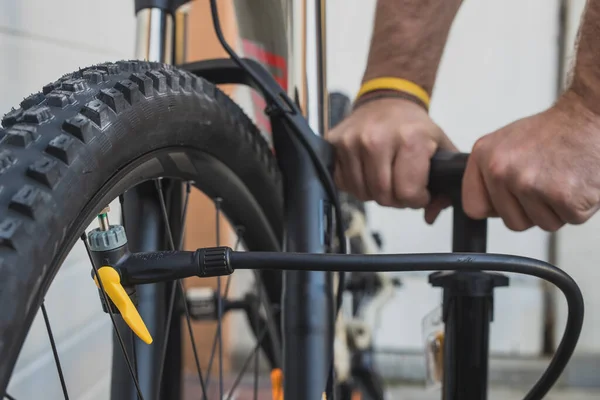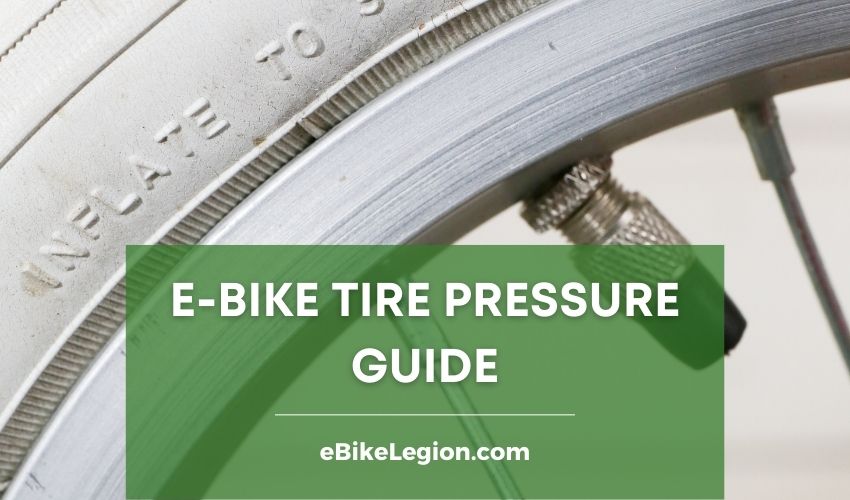Buying an e-bike is one part of your biking journey; taking care of it is another. One of the ways you can maintain your e-bike is by ensuring that it has good tire pressure. To get the best bike rides, it is essential to have the correct tire pressure for your e-bike.
Generally, an electric bike tire pressure for a standard electric bike should be 70 psi.
This mustn’t apply to all-electric bikes because they are no fixed rules or numbers to ensure that your e bike’s tire pressure is accurate. The ideal tire pressure for your e-bike depends on a few factors, which we will cover in this article.
Electric Bike Tire Pressure Factors
Tire pressures vary among e-bikes, and to achieve the optimal tire pressure for your e-bike, you will need to consider some factors, such as:

- The type of tire
- The type of biking or riding style
- Weight (Both the rider weight and luggage weight)
- Weather factor
A great and easy place to start is the tire itself. It might be difficult to read, but the minimum and maximum tire pressure are printed on the sidewall of the tire. Even with this information, be careful as the metrics of these models get changed and updated.
The next question is, how do you get the right pressure?
To do this, you will need to understand the benefits of high and low tire pressure.
Higher vs Lower Tire Pressure
The high and low tire pressure in relation to its rolling resistance is determined based on the terrain and weight of the rider.
Higher tire pressure: When driving on smooth terrain such as paved roads, higher tire pressure is better because it has less rolling resistance and increases speed. For example, some e-bikes with ultra-skinny tires have a recommended tire pressure as high as 120 psi.
With this, most riders prefer to ride with high tire pressures rather than low tire pressures. Also, keep in mind that the recommended pressure printed on the tire sidewalls is usually too high. It doesn’t factor in the weight and various terrain conditions.
What you need to know: The heavier you and your luggage are, the higher the tire pressure required to get the same performance from your electric bikes.
Lower tire pressure: Lower tire pressure is very useful in rainy weather as it gives more grip at the expense of rolling resistance and speed. This also makes electric bicycle tires have excellent shock absorption, making a smoother ride. This pressure setting is also ideal if you need to make a lot of cornering on off-road terrain.
Whichever setting you choose, the tire pressure recommended by the manufacturer should not be exceeded.
Types of Biking
The type of biking you perform is another essential factor you need to consider before setting your e-bike tire pressure.
- Road biking: Freely inflate the tires to the recommended maximum pressure for smooth roads. With little risk of climbing over rocks and roots, you can enjoy a completely comfortable ride even if you inflate your tires to a pressure of 80-130 psi. Of course, higher pressures reduce traction, so you need to work harder to maintain balance.
For off-road, the ground becomes loose and requires more traction. To accommodate this while optimizing speed, use a pressure range of 40-70 psi.
- Mountain biking: High tire pressure is not recommended in rough terrain and rocky areas. To make matters worse, high pressure reduces traction and can lead to injuries in mountainous areas. To avoid both situations, maintain a lower pressure tire pressure of 25-50 psi. The pressure has to be low enough for comfort and a firm grip on the ground, but also high enough to avoid punctures from rocks, sharp objects, and trails.
- Soft surface biking: Soft surfaces like snow, sand, and mud require very low pressures from 5-20 psi. Fat tires are most commonly used in cases like this.
Front and Back Tire Pressure
An experienced electric bike rider tends to have different front tire and back tire pressure settings.
The general rule to follow here is to keep the front tire at a lower pressure than the back tire. This is especially important if you plan to carry a lot of luggage on your electric bike.
It is recommended to inflate both tires to the center setting before wrapping them on an electric bike. If you feel this pressure level is working, you can easily make further adjustments for a smooth ride.
Don’t forget to read the manual for the electric bike because manufacturers also usually recommend front and rear tire pressure. For example, on rad power bikes, the recommended psi is the same.
Rolling Resistance
Tire rolling resistance is the energy a vehicle needs to send to a tire to keep it moving at a constant speed on the road surface. In other words, it’s the effort necessary to keep the tires moving.
But how does tire pressure affect rolling resistance?
If your e-bike tire pressure is low, there will be more rolling resistance. However, this is only a few watts of power in most cases.
Tire pressure has the least impact on this metric, given gravity and wind resistance, but setting higher pressures can have a big impact if you plan a longer ride.
The type of tire you are using also has the greatest effect on rolling resistance. The mountain tires are designed for more grip, so they have the highest rolling resistance. On the other hand, road tires are designed for flat terrain such as pavement, so they have the lowest rolling resistance.
This means that while rolling resistance is a factor, the type of tire you are using is a much bigger factor.
Weather Factor
The weather condition also has an impact on your e-bike tire pressure.
In rainy or wet weather, less pressure is required to ensure a larger tread and more traction (or commonly known grip). According to LeedsBikes.com, “hyperinflation (higher pressure) is often the main cause of accidents in wet conditions.” Therefore, lower the pressure of your tires for your safety.
Cold temperature also requires low pressure. For every 10 degrees Celsius, the tire pressure should drop by 2%. Therefore, deflate the tires for your safety.
Weight of the Rider
The body weight of the rider and the weight of the cargo carried by the rider must also be considered.
- The higher the load, the higher the tire pressure. As the weight on the tire increases, so does the pressure on the tire to withstand that weight. Keep this in mind if you are riding with luggage, a child, or a very heavy backpack.
- The lighter the load, the lower the pressure. If you are a light person, you can escape an unstable ride with the lower pressure of your bike tires and still have your tires carry you effectively.
Tire Pressure and Flat Tires Risks
A smooth ride is essential, but tire pressure also affects the risk of a flat tire. And if you experience many breakdowns, one of the reasons may be your tire pressure.
If there is low pressure, there is a risk of “failure.” It occurs when the tire tube is pinched by the rim and can be prevented by keeping the tire at a higher pressure setting.
However, the air pressure of the e-bike tire should not approach this, not to mention exceeding the recommended pressure setting. You may get a few miles extra, but you risk blowing the tires off.
E-Mbt Tire Pressure
Changing the pneumatics of mountain tires is a bit more complicated than road tires. Especially for mountain bikes, the ideal tire pressure is a balance between grip and stability. However, the starting point is as follows:
- 2.35-2.5 inch tubeless tires: 1.8 Bar (26 psi) front and back
- 2.6-3.0 inch tubeless tires: 1.4 Bar (20 psi) front and back
This can be adjusted accordingly. High pressure supports sidewalls for added protection from the rim. Be careful not to make it too high, as fewer tires will come into contact with the ground, and the ride quality will be rougher.
Low pressure enhances grip and provides ample traction. Softer tires can absorb the terrain and improve cornering. The disadvantages are the high risk of damage to the rim and the low springs. This can lead to instability in ride quality at some speeds.
Proper Tire Pressure Testing
Inflate the tire to half the recommended pressure level and give it a try. Ride an electric bicycle and feel the ride quality of the bicycle. Riding an electric bike on a frequent route will provide you with the best handling of your bike.
If the ride quality is too bumpy, try lowering the pressure a bit. On the other hand, if you feel the rim hit the tire, you need to increase the pressure.
After you`ve come back from the test ride, you can adjust the pressure in 3 PSI increments until you zero in the perfect setting for your needs.
Regular Checkups
No matter what kind of tire you drive, it will be deflated over time. Most air escapes during large temperature changes. Therefore, it is important to check your tire pressure regularly.
The best practice is to check the tire pressure before each ride. You also need to inflate your bike tires with the same pump each time. This is because air pumps vary widely from brand to brand, and maintaining consistency is not an issue when finding the optimal settings for your needs.
Conclusion
There is no such thing as perfect tire pressure or the best tire pressure. All bikes have different tire pressures, and the correct pressure depends on the features of the e-bike tires, such as the type of tire (if they are soft tires or hard tires).
Also, follow the manufacturer’s recommendations. Therefore, be sure to check the recommended minimum and maximum pressure value printed on the tire sidewall. It gives you a good starting point.
You should also understand how more weight impacts your tire pressure.
